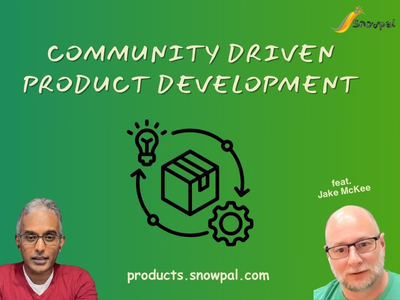Community Driven Product Development (feat. Jake McKee)
Snowpal Podcast: Community Driven Product Development process has three stages: collection, development, and verification.
In this episode, Krish Palaniappan interviews Jake McKee, a consultant specializing in community-driven product development. They discuss the importance of integrating customer voices into the product development process, the three stages of product development, and how community involvement can lead to better products and customer loyalty. Jake shares insights on when to involve the community, how to find the right voices, and the significance of timing in community engagement. A case study on LEGO Mindstorms illustrates the practical application of these concepts. In this conversation, Jake McKee discusses the critical aspects of community-driven product development, emphasizing the importance of defining clear outcomes, engaging the right people, and utilizing effective tools for feedback. He explores the evolving nature of participant roles throughout the development process and the significance of maintaining engagement and expertise. The discussion also touches on the role of AI in facilitating these processes, highlighting both the potential benefits and challenges of integrating technology into community engagement. In this conversation, Krish Palaniappan and Jake McKee explore the intersection of creativity and technology, emphasizing the importance of integrating the arts into STEM education. They discuss cultural perspectives on career choices, the role of creativity in a tech-driven world, and the need for interdisciplinary skills. The conversation also touches on the future of work, the significance of problem-solving skills, and the importance of teaching creative problem-solving to future generations. Finally, they highlight Austin as a unique cultural hub that fosters community and creativity.
Takeaways
Community-driven product development integrates customer voices.
The product development process has three stages: collection, development, and verification.
Involving the community can lead to better product outcomes.
Customer advocacy can be built from the start of the development process.
Finding the right people is essential for effective community engagement.
Timing is crucial; community involvement can vary throughout the development cycle.
Community insights provide emotional context that data alone cannot capture.
Engaging with the community early can prevent potential backlash at launch.
The right voices should represent diverse aspects of the community.
A case study on LEGO Mindstorms highlights the importance of community involvement. Defining clear outcomes is essential for effective product development.
Engaging the right people is crucial at different stages of a project.
Participant roles may evolve as a project progresses.
Maintaining engagement is key to gathering valuable feedback.
Using tools like Slack or Discord can enhance community interaction.
AI can assist in product development but should not replace human creativity.
Feedback should be structured to be actionable for product teams.
Understanding customer needs requires asking the right questions.
Community-driven development can lead to more innovative solutions.
AI's role is to augment human capabilities, not replace them. Creativity is essential in a world increasingly driven by AI.
STEM education should incorporate the arts to foster creativity.
Cultural backgrounds influence career choices and opportunities.
The ability to solve problems is more valuable than technical skills alone.
Teaching creative problem-solving is crucial for future generations.
Productivity should be prioritized over mere efficiency in the workplace.
Interdisciplinary skills are necessary for navigating complex challenges.
Community engagement is vital for successful product development.
Learning must translate into practical application for it to be meaningful.
Austin is a vibrant city that blends diverse cultures and opportunities.
Chapters
00:00 Introduction to Community-Driven Product Development
02:58 Understanding the Three Stages of Product Development
05:59 The Role of Community in Product Market Fit
09:01 When to Involve the Community
11:53 Building Effective Community Engagement Programs
14:58 Finding the Right Voices for Development
17:49 Timing and Its Importance in Community Engagement
21:01 Case Study: LEGO Mindstorms and Community Involvement
29:34 Defining Right Outcomes
33:17 The Importance of the Right People
37:45 Engagement and Expertise in Feedback
41:34 Tools for Community Engagement
46:49 Navigating Customer Feedback
51:07 The Role of AI in Community-Driven Development
01:02:04 The Intersection of Creativity and AI
01:03:34 STEM vs. STEAM: The Importance of Humanities
01:05:00 Cultural Perspectives on Career Choices
01:06:52 The Role of Creativity in a Tech-Driven World
01:10:52 Problem Solving vs. Technical Skills in Development
01:12:35 Teaching Creative Problem Solving to Future Generations
01:15:26 The Future of Work: Productivity vs. Efficiency
01:17:05 Bridging Disciplines: The Need for Interdisciplinary Skills
01:22:31 Applying Insights to Real-World Challenges
01:25:55 Austin: A Unique Cultural Hub
Podcast
(For video version, go to Spotify, Apple, or YouTube)
Transcript
Snowpal Products
Backends as Services on AWS Marketplace
Mobile Apps on App Store and Play Store
Web App
Education Platform for Learners and Course Creators


